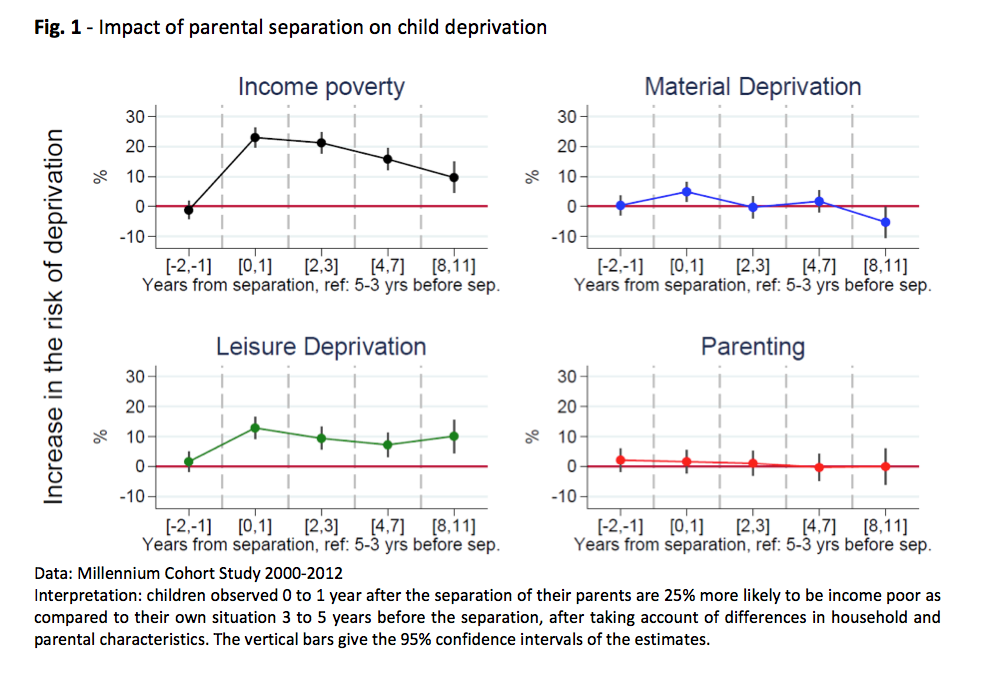Parental separation increases children’s risk of poverty
The proportion of children experiencing parental divorce or separation has increased across Western countries. As a result, in 2014 about 16% of children aged 0 to 17 lived in single-parent household across OECD countries, with considerable cross-national variation ranging from 6% in Turkey to about 23% in the UK and 27% in the United States (OECD, 2015).
A rich literature has shown that divorce and separation are often accompanied by a drop in income, particularly for women and children (Aassve et al., 2007, Brewer et al., 2014, Fisher and Low, 2015), increasing their risk of poverty. However, a separate strand of literature tells us that family income does not always reflect living conditions and well-being, especially for children (UNICEF, 2013). This may be especially true following a separation, when parents may prioritize scant resources towards children to maintain their living standards and home environments. Arguably, therefore, monetary measures may not fully capture the practical impact of parental separation on children’s daily lives.
Accounting for changing needs and multiple spheres of deprivation.
In a recent paper (Leturcq, Panico 2016), we used rich data from the UK Millennium Cohort Study (MCS), which follows over 18,000 children born in 2000-2001 and living in the UK. The Study collects detailed information on a number of dimensions of children lives, starting shortly after birth, and will do so regularly across their life course. MCS families were interviewed when their children were aged about 9 months, 3 years, 5 years, 7 years and 11 years. Data collection is complete for age 16 but these data are not yet available. We used this information to construct indicators capturing children’s experience in different dimensions of their lives, measuring different domains of child deprivation. Therefore, alongside classic measures of monetary poverty (a household is considered as poor if its equivalent income¹ is below 60% of the median equivalent income), we explore how parental separation affects a diverse set of dimensions of childhood deprivation, including access to material goods and housing (such as living in a damp or overcrowded house, not having central heating, etc.), leisure deprivation (including not being able to afford holidays or activities that must be paid for, such as music lessons), and parenting, tapping into the home learning environment (reading and helping with homework), participation in free family activities (going to the park or the library), and home routines.
Children’s needs change as they grow. Multi-dimensional indicators of deprivation have already been created separately for adults and children, but they do not vary according to the children’s ages, and tend to focus on primary-school-aged children, ignoring the early childhood period. We deemed it preferable to adapt existing methodologies, notably that of Alkire and Foster (2015), to study the same dimensions of deprivation over the life course of children, but taking into account how the needs of children change with age, from shortly after birth until the beginning of secondary school. So, for example, when we looked at parenting, we included indicators such as whether parents sing songs and read books to their children when they are 3 years old, while at ages 5 and 7, we analyzed whether parents help them with reading. By age 11, we looked at whether parents help them with their homework or attend school meetings. Another example is lack of access to the internet or a computer at home: this may not be relevant in early childhood, but becomes very important by the age of 11, when it is a strong marker of deprivation.
In our sample, we found that about 18% of children are monetarily poor at any given point, and about 20% of children are deprived on two or more of the deprivation domains that we studied. We consider these children as being “generally deprived”. These two groups do not always overlap: only 9% of children in our sample are both monetarily poor and deprived.
So, how do children experience parental separation?
Studying the impact of separation on childhood poverty and deprivation is difficult because parents who separate are usually different from those who do not, even before the divorce or separation occurs. Parents who eventually separate are on average less educated, have lower incomes, and are less likely to be employed before separation. However, even after controlling for all the differences that we could observe (that is, that were available in the dataset, such as parental education, age, and employment status),² we still registered a notable increase in the risk of monetary poverty associated with parental separation, with a sharp rise in income poverty in the short term, and only a partial recovery in the long term (Figure 1).
Looking at the different dimensions of deprivation explained above, we found a strong increase in leisure deprivation following parental separation (for example, being able to afford holidays, music lessons, etc.). However, we found only a small short-term effect on material deprivation, perhaps because parents prioritize their (reduced) incomes towards their children’s basic needs, such as providing them with a safe, warm home. We also did not find any impact of parental separation on parenting involvement and children’s day-to-day routines. This suggests that, even during the chaotic time around separation, parents prioritize maintaining parenting activities and routines with their children. However, let us remind our readers that the families who eventually experience a breakdown tend to start out with fewer material or cultural resources. Their children, therefore, even if not particularly affected by parental separation, remain a relatively deprived group throughout their lives.
We also found that children’s post-separation trajectories differ according to their mother’s level of education, suggesting that the parents’ pre-separation social and economic capital may play an important role. In fact, we found that the negative long-term effects of parental separation on child poverty and deprivation are only found in less advantaged groups. For more advantaged groups, while the risk of deprivation increases slightly in the short term, the long term impact of parental separation on children’s lives is negligible.
Bibliography
Aassve Arnstein, Betti Gianni, Mazzuco Stefano, Mencarini Letizia (2007) Marital disruption and economic well-being: A comparative analysis. Journal of the Royal Statistical Society: Series A (Statistics in Society), 170(3):781-799,.
Alkire Sabina, Foster James, Seth Suman, Santos Maria Emma, Roche José Manuel, Ballón Paola (2015) Multidimensional Poverty Measurement and Analysis, New York, Oxford University Press.
Brewer Mike, Nandi Alita, et al. (2014) Partnership dissolution: how does it affect income, employment and well-being? Institute for Social and Economic Research, University of Essex, n. 30.
Fisher Hayley, Low Hamish (2015). Financial implications of relationship breakdown: does marriage matter? Review of Economics of the Household, 13(4):735-769.
Leturcq Marion, Panico Lidia (2016) The long-term effect of parental separation on childhood financial poverty and multidimensional deprivation: a lifecourse approach, Documents de travail INED, n° 228, 44 pages.
OECD – Organization for Economic Co-Operation and Development. Family Database (2015)
Unicef (2013) Child Well Being in Rich Countries: A Comparative Overview. UNICEF Office of Research-Innocenti.
Foot note
¹The equivalent income transforms monetary income into a value that takes the household dimension into account. The resulting figure is therefore (more easily) comparable between large and small households.
² If the controls are introduced properly, and if there is no other unobserved but systematic effect, the differences in the changes in the risk of deprivation or poverty due to these initial conditions are eliminated or, at least, greatly reduced.



